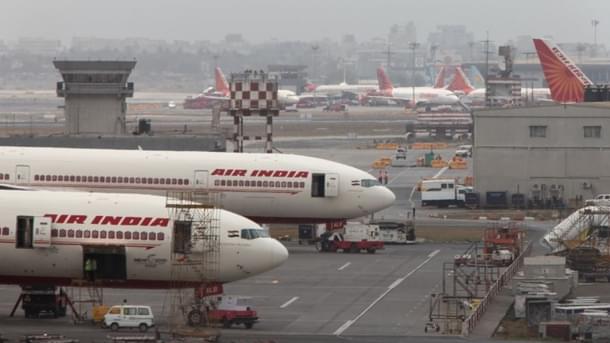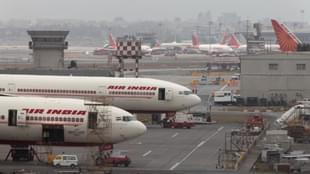Business
Air India Disinvestment: Liabilities Are The Elephant In The Room For Potential Bidders
Sindhu Bhattacharya
Feb 12, 2018, 03:15 PM | Updated 03:15 PM IST
Save & read from anywhere!
Bookmark stories for easy access on any device or the Swarajya app.


The Union government is sparing no effort to expedite the process of strategic disinvestment from Air India, the largest such exercise in Independent India. It has put in place a high-level group of ministers to decide the modalities of this crucial process. The intent is to offload at least 51 per cent in the bleeding national carrier to a private entity so that the government no longer stays in the airline business.
The key question is: despite the noble intentions, does the government have a handle on the actual financial condition of the Maharaja to dress it up for sale? Are the books of the airline in order?
The elephant in the room, according to potential bidders, is the extent of liabilities on the airline’s books. A representative of one potential bidder said no one seems to know the extent of liabilities, present and contingent, on the airline and this one figure may well determine the success of the disinvestment.
“Everyone more or less knows the extent of losses at Air India. But different figures are emerging on the liabilities. What are the valuations for ground handling, land assets, bilateral traffic rights, aircraft – all this needs to be assigned. Then, liabilities need to be accounted for. These figures are being brushed under the carpet,” this person said.
Remember, Civil Aviation Minister A Gajapathi Raju has said several times in the past that the airline’s books are “bad”. Late last month, he was quoted saying that the debt on Air India’s books may be closer to Rs 70,000 crore rather than the previously thought Rs 50,000 crore.
That is an increase of about 40 per cent. Are there hidden gems in the airline’s books which are only now being discovered as it readies for sell-off? Air India officials pointed out that the debt was close to Rs 50,000 crore if only long-term debt and working-capital debt were considered. But if all the current and contingent liabilities were included, another about Rs 20,000 crore gets added, taking the total debt close to Rs 70,000 crore. While this is sound accounting, it is certain to send out confusing signals to potential investors.
The government has now indicated that it wants to break up the airline into four distinct entities and transfer some of the unsustainable debt into a separate entity. This will likely unlock valuations and help potential bidders in evaluating the merits of each part of Air India.
How clueless the government is about Air India’s books is apparent from the latest disclosure about the airline’s financial performance in 2016-17. On the face of it, it seems the airline added about Rs 1,930 crore to its net loss overnight due to certain accounting practices.
In this written reply in Lok Sabha, Minister of State for Civil Aviation Jayant Sinha said on 21 December last year that the provisional net loss of Air India was Rs 3,643 crore for 2016-17. Since this was marginally lower than the net loss declared in the previous fiscal (2015-16) and also because this was the second year that Air India was expected to declare a modest operational profit, there was all-round cheer. The loss-laden and over-leveraged airline was finally turning around!
Now, within a span of a one and a half months, the net loss figure has got inflated to Rs 5,765.16 crore.
In this reply on Thursday (8 February), Sinha told Lok Sabha that the net loss for 2016-17 was actually Rs 5,765.16 crore. About Rs 1,930 crore more than thought provisioned for. In other words, higher by almost 50 per cent. Or the airline added almost Rs 5 crore of daily loss to its provisional net loss each day of the fiscal year 2017. In effect, Air India lost about Rs 16 crore each day of 2016-17.
The mystery of this additional net loss has been explained by Air India officials thus: Rs 850 crore of this is due to something called “Served from India Scheme (SFIS) scrips”. These can no longer be utilised as they have expired, and airline officials said, “we are trying for an extension for the validity of these scrips”. The remaining Rs 1,300 crore of the added net loss is apparently due to “additional provisioning” arising out of the Dharmadikari report.
The SFIS is duty credit worth 10 per cent of the foreign exchange earned by Indian service providers to enable them to make strong Indian brands. This duty credit scrip can also be used to pay excise duty for procurement of items, such as fuel, from domestic sources. But if it expired in 2011, why is Air India not accounting for the loss arising from these scrips in provisional accounts each year?
In its annual report for 2015-16, the airline’s auditors have said that Air India was issued the total unutilised duty credit scrips for 2007-08, 2009-10 and 2010-11 and as on 31 March 2015, these amounted to Rs 1,155.15 crore. The company was “actively following up the matter of extension/renewal of the unutilized scrips with the appropriate authorities due to which the company was issued SFIS Scrips for Rs.300 crore in May/Jun 2016 pertaining to FY 2007-08. The company is vigorously pursuing for the renewal/extension of the balance amount of scrips of Rs.8,55.15 crore”.
Essentially, this issue with SFIS scrips is an old one and the airline was perhaps hopeful that this time the government would allow it to use expired scrips.
So while operational efficiencies and a benign oil price helped it post an operational profit, Air India’s bottom line remains mired in red ink.
How did competitors do in that same year? IndiGo, the largest airline by passenger volume, reported a net profit of Rs 1,659.2 crore for the same 12 months. Or a net profit of Rs 4.54 crore each day. SpiceJet reported a net profit of Rs 430.72 crore or a daily net profit of about Rs 1.2 crore. Jet Airways reported Rs 438.4 crore net profit for the same 12 months, or a daily profit close to SpiceJet’s at about Rs 1.2 crore.
The fact that Air India continued to pile losses when private airlines were declaring profits underscores the need for disinvestment. Only, this process needs far more transparency in numbers than has been seen till now.
Sindhu Bhattacharya is a senior journalist.





